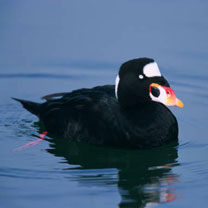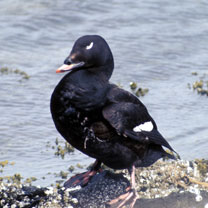Knauss legislative fellowships in Congress help build careers — and they're fun and educational. See our video and fact sheet for details.
Ducks at Sea (podcast)

Scientists Explore the Fate of the Bay's Sea Ducks
When most people think of ducks, their minds turn to mallards, those quacking residents of ponds across the United States. But the Chesapeake Bay is home to many more species of ducks. The oddest may be the sea ducks. These birds — which include long-tailed ducks, black scoters, white-winged scoters, and others — fly south to the Bay from Canada every winter. They’re elusive, sticking to the estuary’s deeper waters, and also threatened, scientists say. Research suggests that 13 out of the 15 species of sea ducks that live in North America are declining. At the Patuxent Wildlife Research Center in Laurel, Maryland, scientists are following the struggles of these birds on the Chesapeake. In many cases, the success or failure of sea ducks may be tied to the fate of oyster reefs. Daniel Strain brings us more in this podcast.
.jpg)
[Water tank sounds]
Alicia Berlin: You want some? You going to be shy? That’s a boy.
 |
 |
|
Surf scoter (Melanitta perspicillata), top, and white-winged scoter (Melanitta fusca), bottom. Photograph at the top of the page: long-tailed duck (Clangula hyemalis). |
Daniel Strain: Alicia Berlin knows the way to a duck’s heart. The trick seems to be mealworms. Right now, the researcher is poised over a massive aquarium tank kept at the Patuxent Wildlife Research Center in Laurel, Maryland. Inside is a single, brown duck. He’s happily picking some wriggling mealworms from Berlin’s outstretched hand.
Ducks have long been a favorite of both hunters and wildlife painters on the Chesapeake Bay — every winter, the estuary is overrun by nearly one million migratory waterfowl, most of them ducks or geese. But Berlin’s friend in the tank isn’t an ordinary puddle duck. He’s a type of waterfowl known as a sea duck. These birds are much harder to find.
AB: When you’re out, even if you’re an avid hunter, you’re not going to see the sea ducks close to shore. They usually hang out in the, within the Chesapeake Bay, it’s in the 15 to 20 feet zone.
[Long-tailed duck calls]
DS: Those are long-tailed ducks. They’re one of nine species of sea ducks that you can find in the deeper parts of the Bay. There are also common goldeneyes and three species of scoters, including white-winged, black, and surf scoters. They are related to backyard ducks and geese, only they’re much more intrepid.
Every winter around December, sea ducks fly south to the Chesapeake Bay and other marine sites on the mid-Atlantic from much chillier waters in Canada. But, as Berlin explains, they tend to stay in the middle of the Bay where the water is about 15 to 20 feet deep. There, they go diving for mussels and other Bay delicacies.
They don’t sound like ordinary ducks, either.
AB: You might hear the blacks. They have a really high-pitched whistle. It’s like a [she whistles] kind of thing.
DS: She means black scoters. And they sound a bit like this…
[Black scoter calls]
AB: And it’s really eerie when you are out on the water and you hear a hundred thousand of them doing that.
DS: That other-worldliness hints at just how little we know about these birds. Sea ducks have never been well studied, in part because they live so far from shore. But scientists have noticed that many of these birds are struggling, both globally and in the Chesapeake Bay. Of the 15 species of sea ducks that live in North America, for instance, researchers think that 13 are shrinking at a steady pace.
Along the Atlantic Coast, scientists report that three species of sea duck are on the decline, although it’s hard to say by how much: they are the long-tailed ducks, surf scoters, and those eerie, whistling black scoters. Here on the Chesapeake Bay, it’s those last ones — the black scoters — that seem to have become especially rare.
Berlin and her colleagues are working to find out why sea duck numbers are dropping. She, at least, thinks it could have something to do with their stomachs. Which brings us back to our friend in the aquarium tank, who’s built up a bit of an appetite.
AB: This is an immature, so you might not be able to guess, but this is a white-wing.
DS: That’s white-winged scoter. The duck is about a year old now.
And he is supposed to be learning how to play a simple game. Researchers here are trying to train this duck so that he can participate in an experiment exploring duck hearing. When he hears a beep like this…
[Beeping sound]
…he’s supposed to tap his bill on a switch. Then he will get a treat. Of mealworms.
Unfortunately, he’s a bit of a slow learner.
AB: Well, he’s trying.
DS: Berlin is trying, too. She’s using these tanks to study how the fate of sea duck species may be tied to the health of the Chesapeake ecosystem. More precisely, she’s trying to figure out how much the survival of these birds depends on certain food sources in the Bay. She has done that by watching them eat — in this case, mussels and clams.
AB: Basically, I would line the bottom of the tank with a known density of either prey item, mussels or clams, and let the bird dive on it and forage on it.
These types of experiments are important because sea ducks living on the Bay have seen their habitats change a lot in recent decades. The estuary’s once-famous oyster reefs have all but disappeared and so have many of the Bay-grass beds that grew along the shore. Some of these changes may affect the birds’ ability to find food. Take the Bay’s three species of scoters: these sea ducks mostly eat oysters and other bivalves.
AB: The hooked mussel was their primary prey item, which only occurs on hard substrates and on the Chesapeake Bay that just happens to be the oyster reefs.
DS: And oyster reefs have mostly vanished from the Bay — largely because of overfishing and disease. Without reefs, hooked mussels might begin to vanish. That means that sea ducks would lose their primary source of food. The birds do have other sources of energy, Berlin notes — dwarf surf clams, in particular. These bivalves are small and lie along the sandier stretches of the Bay, meaning they don’t depend on oyster reefs for their survival.
But they may not be a good snack for sea ducks. In fact, when all sea ducks have to eat are these clams, they’ll dive down for serving after serving, Berlin has found. It’s like eating pistachios — you need to consume a lot to satisfy your hunger. Hooked mussels, on the other hand, are larger and chock-full of energy. Which leads Berlin to suggest that...
AB: If we lost all the mussels, could they actually survive on the clam? And they really can’t, that was the bottom line.
DS: Mussels, as Berlin puts it, are like one big pastry, only more nutritious.
AB: The mussel was really like, I always say this, the big Twinkie, Ghostbusters reference. That is the big Twinkie for them. It gives them the most bang for their buck.
DS: It isn’t clear just how much the decline of some sea duck species on the Bay is tied to the loss of oyster reefs, and of the hooked mussels that live there — that will take more study. But Berlin suspects that changes to the birds’ food might play a role.
In the end, sea ducks give us one more good reason to restore oyster reefs on the Chesapeake, she says. These reefs support a wide network of teeming life — which stretches from small bivalves up to birds. So how sea ducks fare could tell us a lot about the health of the Bay ecosystem.
[Water-tank sounds, beeping]
AB: There you go.
DS: Berlin’s young duck hears the beep, then hits his target. As a reward, he gets a beakful of nice, juicy mealworms. He’s learning the game, after all. Berlin, however, has just scratched the surface of what she’d like to learn about sea ducks on the Bay.
The long-tailed duck calls in this podcast were provided by the Borror Laboratory of Bioacoustics at the Ohio State University in Columbus and used with permission. All rights reserved. The black scoter calls were recorded by Paul Driver and used with permission.
Photo credits: Long-tailed duck, Wolfgang Wander, Wikimedia Commons; surf scoter, Gary Kramer, USFWS; and white-winged scoter, USFWS.
This podcast was produced by Maryland Sea Grant, part of the University of Maryland. We support scientific research, education, and public policy to enhance the ecology of the Chesapeake Bay and the businesses and jobs that depend on it.





